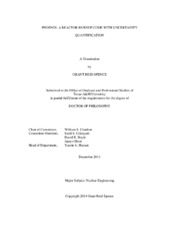| dc.contributor.advisor | Charlton, William S | |
| dc.creator | Spence, Grant R | |
| dc.date.accessioned | 2015-04-28T15:34:19Z | |
| dc.date.available | 2016-12-01T06:36:01Z | |
| dc.date.created | 2014-12 | |
| dc.date.issued | 2014-12-15 | |
| dc.date.submitted | December 2014 | |
| dc.identifier.uri | https://hdl.handle.net/1969.1/154069 | |
| dc.description.abstract | Codes for accurately simulating the core composition changes for nuclear reactors have developed as computing technology developed. The desire to understand neutronics, material compositions, and reactor parameters as a function of time has been, and will continue to be, an area of great interest in nuclear research. Several methods have been developed to simulate reactor burnup; however, quantifying the uncertainty in reactor burnup simulations is in its relative infancy. This research developed a fundamentally different approach to calculate burnup simulation uncertainty using perturbations and regression methods. In this work, a computer software package called PHOENIX was developed that simulates reactor burnup and provides a quantitative prediction of the systematic uncertainty associated with simulation modeling parameters. PHOENIX is a “linkage” code that connects the Monte Carlo N-Particle transport code MCNP6 to the buildup and depletion code ORIGEN-S.
A verification and validation analysis was performed on four different reactor configurations using PHOENIX. The validation analysis consisted of two separate components: a code-to-code validation with MONTEBURNS 2.0 and a perturbation validation analysis using two different perturbation methods. Each analysis observed differences in reactor parameters and gram compositions for a selected isotopic suite, and compared them to a pre-determined validation criteria. For the code-to-code validation component, every reactor configuration simulated in PHOENIX produced reactor parameter values within five percent of the values provided by MONTEBURNS 2.0. A majority of the isotopes simulated in each code also produced gram quantities with differences of less than five percent. Similarly, the perturbation validation analysis confirmed that the simulation parameters produced by PHOENIX using each perturbation method contained differences of less than five percent for a majority of the cases. The outlying instances where a reactor parameter or isotopic composition did not pass validation criteria are explained in detail. The results from the validation analysis showed that PHOENIX produces valid estimates of reactor core compositions throughout burnup. | en |
| dc.format.mimetype | application/pdf | |
| dc.language.iso | en | |
| dc.subject | Reactor Burnup | en |
| dc.subject | Uncertainty Quantification | en |
| dc.subject | Monte Carlo Burnup | en |
| dc.subject | MONTEBURNS | en |
| dc.subject | ORIGEN | en |
| dc.title | Phoenix: A Reactor Burnup Code With Uncertainty Quantification | en |
| dc.type | Thesis | en |
| thesis.degree.department | Nuclear Engineering | en |
| thesis.degree.discipline | Nuclear Engineering | en |
| thesis.degree.grantor | Texas A & M University | en |
| thesis.degree.name | Doctor of Philosophy | en |
| thesis.degree.level | Doctoral | en |
| dc.contributor.committeeMember | Boyle, David R | |
| dc.contributor.committeeMember | Olsen, James | |
| dc.contributor.committeeMember | Chirayath, Sunil S | |
| dc.type.material | text | en |
| dc.date.updated | 2015-04-28T15:34:19Z | |
| local.embargo.terms | 2016-12-01 | |
| local.etdauthor.orcid | 0000-0002-9441-9392 | |


